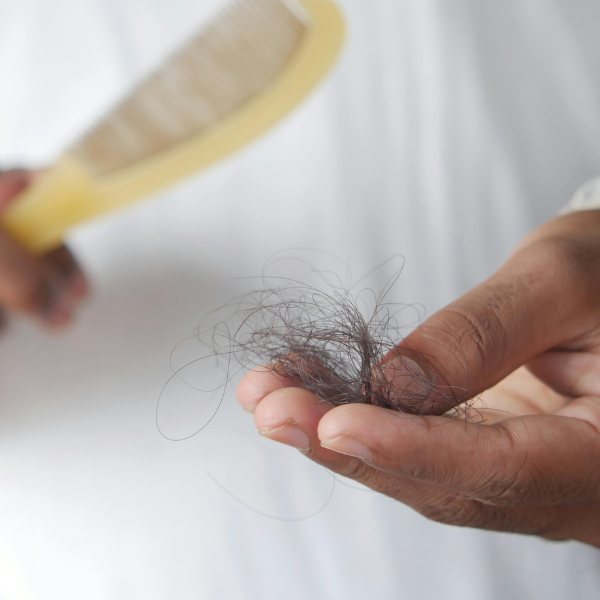Postpartum Hair Loss Hits Hard—Here’s How to Handle It
What to Say and How to Help Clients Feel Their Best
Many new moms are caught off guard by postpartum hair loss—it’s frustrating, emotional and hard to manage. Ahead, board-certified NYC cosmetic dermatologist Dr. Michele Green (@michelegreenmd) breaks down why it happens, how long it lasts and other postpartum hair loss faqs. And, Natalie Ruzgis (@natalieruzgis), Redken International Artist, shares some common concerns she hears in the salon and how to address them.
What Is Postpartum Hair Loss and Why Does It Happen?
Postpartum hair loss is a short-term condition that causes excessive shedding in the months after giving birth. It happens when hormonal changes during and after pregnancy disrupt the natural hair growth cycle.
“During the third trimester, estrogen levels rise significantly, promoting hair retention,” explains Dr. Green. “After giving birth, estrogen levels drop, leading to excessive shedding as hair follicles return to their natural cycle.”
While this hair loss can be alarming, Dr. Green assures it is a normal part of postpartum recovery. Remind your clients that they’re not alone—many new mothers experience this, and their hair will gradually return to its natural growth pattern.
How Long Does Postpartum Hair Loss Last?
Dr. Green says postpartum hair loss typically begins about three months after childbirth and can last six to fifteen months.
“This is a temporary condition that eventually resolves itself,” she explains. “The duration varies, but most women notice improvement within a year.”
What Are the Signs of Postpartum Hair Loss?
Dr. Green explains that the first noticeable sign is increased hair shedding in the shower, on a brush or around the home. “You may notice more pronounced thinning around the temples, and some individuals experience a slight recession in this area,” she says.
How to Navigate Common Client Concerns
Postpartum hair loss can be an emotional and challenging experience, leaving many clients worried about the changes they see. These concerns can be overwhelming—but with years of experience, Natalie, a Redken International Artist, knows how to reassure clients and provide practical solutions. Here’s how she approaches these conversations:
- “Am I going bald? Will it grow back?!”
“This is the number one panic moment. I try to communicate the cycles that hair goes through during pregnancy and postpartum. If someone is really concerned, I do think it’s best to refer them to a dermatologist,” Natalie explains.
- “My hair is shedding everywhere.”
“Clients freak out when they see hair coming out in clumps, especially in the shower,” says Natalie. “I remind them that it’s all about the hair cycle—those strands were just hanging on during pregnancy and are now naturally shedding.”
- “I swear my hair wasn’t this texture before pregnancy—what’s going on?”
“Some moms notice their hair feels finer or frizzier. Using a leave-in conditioner or light pomade has helped lay those baby hair down until they’re long enough to blend in,” Natalie explains.
- “I need an easy, low-maintenance way to hide my thinning hairline.”
Natalie recommends invisible bond extensions to clients who don’t want to compromise their hairstyle. If they’re open to cutting, she recommends Sabrina Carpenter-style curtain bangs or bottleneck bangs, two of the biggest haircut trends of 2024. “I love that curtain and bottleneck bangs are still so on trend! This is a beautiful way to camouflage the shed and new growth hair areas.”
- “I used to have a full hairline, but now it looks so sparse. Help!”
“I recommend soft, face-framing layers and strategic styling to help disguise those sparse areas while new growth comes in,” Natalie explains. Adding volume with extensions is another way to address thinning along the hairline, but she cautions against traditional extensions like wefts, tape-ins and k-tips. “They can’t always reach delicate areas like the hairline, where many experience hormonal hair loss,” she says.
Natalie uses the V-Light extension method to install Hotheads® Hair Extensions for clients wanting to add coverage. “These invisible micro bonds are fully customizable to match the root color, making them virtually undetectable,” she says. “They’re ultra-lightweight, shed naturally over three to six weeks and take just 15 minutes to install.”

Click here to learn more about V-Light extensions
Postpartum hair loss is temporary, but the right support can make a lasting difference. With expert styling, thoughtful language and reassurance, you can help new moms feel confident as their hair regrows.





